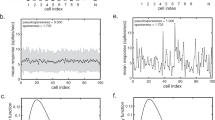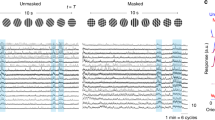Abstract.
We consider the problem of estimating a small stimulus-induced response to stimulation that is masked by a fluctuating background when measurements of the background in the absence of stimulation are available, as is common in optical imaging of the cortex and in many other experimental situations. Two related methods based on the Karhunen-Loève procedure are discussed. One seeks the function, an indicator function, that is most parallel to the response data and most orthogonal to the background data. The second removes the subspace spanned by the background from the response. Numerical investigations on simulated optical imaging data show that the first method is generally superior. Connections between the two methods and techniques for assessing the quality of the result are discussed.
Similar content being viewed by others
Author information
Authors and Affiliations
Additional information
Received: 17 January 1997 / Accepted in revised form: 4 August 1997
Rights and permissions
About this article
Cite this article
Everson, R., Knight, B. & Sirovich, L. Separating spatially distributed response to stimulation from background. I. Optical imaging. Biol Cybern 77, 407–417 (1997). https://doi.org/10.1007/s004220050400
Issue Date:
DOI: https://doi.org/10.1007/s004220050400




